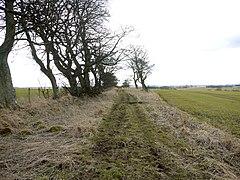Devil's Causeway
| Devil's Causeway | |
|---|---|

Devil's Causeway near Hartburn, Northumberland
|
|

Northumberland
|
|
|
|
|
| OS grid reference | NU108092 |
| Coordinates | 55°18′29″N 1°48′32″W / 55.308°N 1.809°WCoordinates: 55°18′29″N 1°48′32″W / 55.308°N 1.809°W |
|
|
The Devil's Causeway is a Roman road in Northumberland, in North East England. It branches off Dere Street north of Corbridge and can be traced through Northumberland for about 55 miles (89 km) north to Berwick-upon-Tweed.
The Devil’s Causeway starts at Port Gate, now a roundabout, where the Roman Dere Street (A68 road) crosses the military road. To the north of Corbridge at a place called Port Gate, the Roman Dere Street crosses Hadrian's Wall as it continues north into Redesdale on its way to Caledonia. Another Roman road known as the Devil’s Causeway, joins Dere Street at Portgate, and can be traced north eastwards across Northumberland, to the mouth of the River Tweed at Berwick-Upon-Tweed.
Less than 1 mile (2 km) to the east is the Roman fort of Onnum, and it is probable that the Causeway was patrolled by a cavalry unit based there.
The fort at Halton Chesters was built across the line of the wall facing north, half way between milecastles 21 and 22 about 0.5 miles (0.80 km) east of Dere Street. The original Hadrianic fort was rather squat in outline, almost square, measuring some 440 feet north-south by 400 feet east-west, with an area just over 4 acres (c. 134 x 122 m; 1.6 ha).
LEG VI V P F FEC
"The Sixth Victorious Legion, Loyal and Faithful, made this."
A dedicatory slab from the west gate of the fort tells us that the Sixth Legion were responsible for the initial building work, but unfortunately, does not give us the name of the original garrison. It is likely, but not proven, that the Hadrianic unit was a cohors quingenaria equitata, an auxiliary force containing a nominal five-hundred men, approximately half of which were mounted. Units of this type have been identified at many Wall forts, and would have been ideally placed here, the infantry contingent to guard the Fort and Wall, and the cavalry to patrol along Dere Street and the Devil's Causeway to the north.
...
Wikipedia

